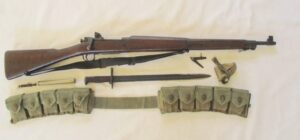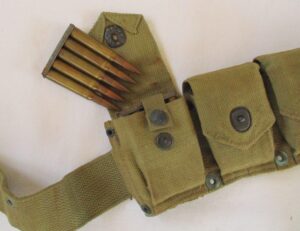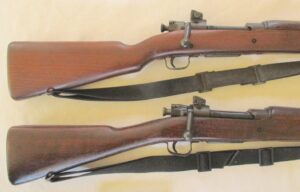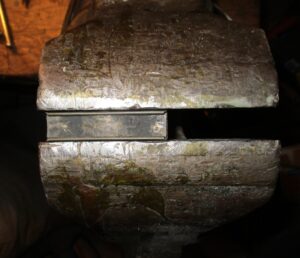
By Jim Dickson|Contributing Editor
Development of the M1903A3 Springfield bolt-action rifle began in World War I and some examples were produced in the 1930’s.
WW2 was when production took off though and the Remington gun makers and the Smith Corona typewriter company churned out thousands of them. Famed gun designer Max Atchisson always said that typewriter companies made the best guns and certainly no one made a better M1903A3 Springfield than Smith Corona. Always reliable and superbly accurate, they contributed much to the already firm reputation of the M1903 Springfield series.
The most obvious deviation from the original M1903 design was the fine rear peep sight. Simple and reliable it never was troublesome, unlike the early versions of the M1 Garand rear sight, and it was far easier for most soldiers to shoot with fine accuracy than the earlier leaf sight.
When the rear sight was left off and a Lyman Alaskan scope mounted instead it became the famed M1903A4 sniper rifle.
The front sight was the old ordnance favorite narrow blade with a removable small tunnel protector that sometimes interfered with sighting. An inverted V as used in Europe would have been better as it needed no front sight protector and was more easily seen in low light conditions. It also was just as accurate for fine precision shooting.

Less obvious was the simplification of the design. The total number of parts was reduced from 91 to 79. That’s 12 less parts to go wrong. Other parts were redesigned for faster manufacture including the use of stampings where practical. Only 24 parts were unaffected. Regrettably the 13-inch length of pull on the stock so dear to the hearts of the Army Ordnance brass was retained. This short stock meant that the troops would lower the rifle from their shoulder when working the bolt so that they didn’t ram the cocking extension into their eye when manipulating the bolt quickly.
This eye injury still occurred at times though and could have been prevented by a 15-inch length of pull like the Thompson SMG had. I am 6’2” and take a 15 9/16” length of pull on my stocks.
Pistol grip stocks are reputed to be slightly better at handling recoil because of positioning the palm of the hand to take some of the shock but straight grip stocks point better and are better for bayonet fighting. At one point someone decided that they could take a straight grip stock blank and make a half pistol grip stock for these rifles. These “Scant grip” rifles never found favor with me.

When combined with the M1905 bayonet with its 16-inch blade and a straight grip stock the M1903A3 became the world’s finest bayonet fighting rifle. This perfectly balanced combination saved more lives than it gets credit for in close quarters combat. There was more hand to hand combat in the Pacific theater of operations than people today realize. Dense jungle combined with Japanese determined to get into hand to hand combat resulted in fixed bayonets becoming routine
The M1903A3 saw widespread use in WWII in all theaters of operation and was sometimes preferred for its superior accuracy over the M1 rifle. It should be noted that there has been an ongoing debate for years as to whether a bolt action sniper rifle or a semi-auto sniper rifle is best. That should be reassuring to users of M1903A4 sniper rifles.
Some served in the Korean war as well. I knew one army doctor who used a M1903A3 to shoot attacking communist soldiers.
During the Viet Nam War, the M1903A3 was still issued for iron sight sniping where it proved as effective as ever. There was one man on convoy guarding duty who always had a grenade launcher on his M1903A3 backed by a full magazine of ball ammo. Nobody ever wanted to give him anything else for a weapon. He was too valuable with his Springfield. Some of the M1903A4 sniper rifles continued to serve there as well.
In more recent years, troops stationed at arctic locations have used these guns for polar bear protection. At arctic temperatures they are more sure in operation than the M1 or M14 plus they can use 220-grain soft point ammo. Bears aren’t protected by the Geneva convention rules against expanding bullets.
Most of the remaining stocks of M1903A3 and M1903A4 were disposed of through the DCM at bargain prices quite unlike the high prices charged today. Back then the idea was to promote civilian marksmanship. To the best of my recollection my rifle cost $14 plus $4 shipping back then and a M1905 bayonet from P&S Sales set me back $3.50.
While some were left unaltered, many were butchered by “Sporterizing” them. The gun at 8.25 pounds was already at the minimum weight for comfortable recoil and cutting off all the wood that they could resulted in turning them into a real kicker that made flinching a whole lot more likely. The wide military butt plate spreads recoil far better than a narrow commercial type butt with a rubber recoil pad. Except for the sorbothane pads I cannot tell that the standard commercial recoil pads work at all.
The military issue rear sight is as perfect an iron sight as possible yet these were often replaced by commercial sights of far less capability. The military had already made the best rifle that they could possibly make for the most demanding conditions a rifleman will ever face. The wise owner left them as they were figuring if they wanted a commercial rifle they would go buy one. Today the unaltered Springfields are valuable collectors’ items while the “Sporterized” ones are just another used gun.
For civilian use the M1903A3 Springfield is as near to the perfect hunting rifle for all North American game from deer up as you can find. While some folks want a bigger caliber for Alaskan brown bear many guides have gone on record wanting their clients to use the .30-06 with 180 grain bullets and shoot through the lungs on brown bear. This is a proven formula for success.
For African use the .30-06 is as fine a plains game caliber as you could ask for. Whether hunting for meat or trophies it gets the job done efficiently.
The 30-06 is one of the most versatile full power rifle cartridges with factory loads ranging from light varmint loads to 220-grain bear stoppers. Designed to be the most powerful cartridge that a soldier could fire 100 rounds a day with without flinching it fills most hunting needs better than its many rivals.

A big advantage of the military bolt actions over commercial ones is that you can use the five-round stripper clips for fast loading. If some of your stripper clips are not holding the cartridges tight enough put them in a vise and carefully squeeze the sides in to tighten them.
For this article I had 480 rounds of ammo for test firing consisting of:
20 rounds of Black hills 168 gr. ELD-M which is about as perfect a deer load as you can ask for. It shoots to the military sights out to 400 yards but it’s trajectory is a little flatter than the G.I. load past there.
100 rounds of Barnaul 168 gr. FMJ BT Military type ammo that I would trust in any war.
40 rounds of Georgia Arms 150 grain FMJ loaded to safe levels for M1 Garands. Unlike the M1941 Johnson rifle the M1 Garand does not hold up well under hot loads. This is first class ammo from a small company dedicated to growing by making quality ammo.
120 rounds of Prvi Partizan Rifle Line 150 grain FMJ loaded to safe levels for M1 Garands. An old, well respected name in Europe but new to many Americans, I have had only good experiences with their fine ammo.
100 rounds of Hornady 150 grain SST SPF which use the latest powders to give an extra 200 FPS velocity without added pressure. It has a muzzle velocity of 3080 FPS.
100 rounds of Hornady 178 grain ELD-X @ 2750 FPS which is a fine load for bear and wild hogs
The Smith Corona Springfield lived up to the Springfield’s reputation for accuracy consistently delivering one inch groups at 100 yards when I did my part.
The M1903A3 Springfield represents the epitome of the bolt action battle rifle. It also gives sterling service as a bolt action sporting rifle just as it is. What more can you ask of it?



